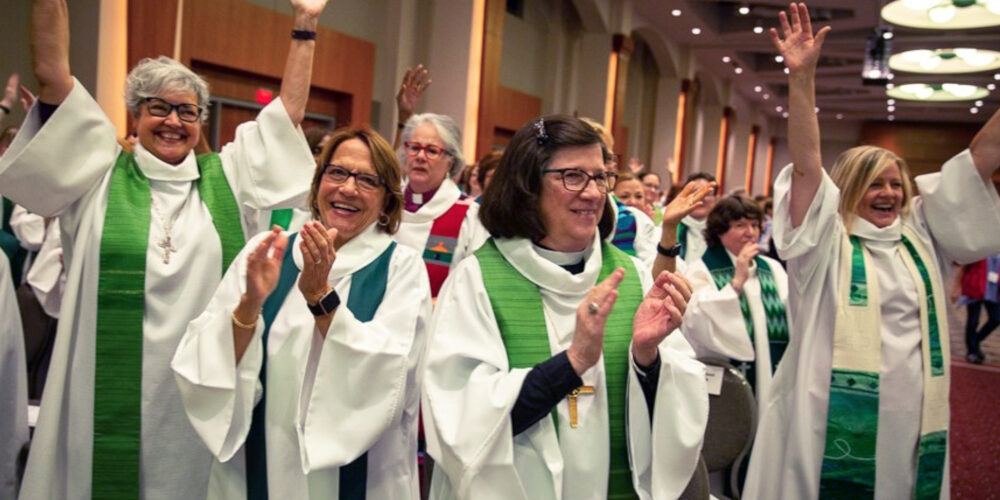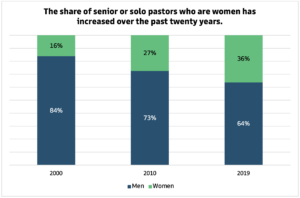Lutheran women in the United States first gained the right to become ordained clergy in 1970 when the conventions of two predecessor denominations to the Evangelical Lutheran Church in America (ELCA) voted to approve the ordination of women that year[1]. In 1981, more than 10 years since Lutheran women in the United States gained the right to serve churches as ordained clergy, less than 3 percent of clergy in either of these two predecessor denominations were women. Women continued to become ordained ministers in greater numbers in the following decades. In 1990, 35 percent (157 women out of 315) of all those newly ordained that year were women[2].
So how have clergy women in the Evangelical Lutheran Church in America been faring during the past twenty years? To discover this, we analyzed data on ELCA congregations and clergy for the period of 2000 to 2019. Here are some of our main findings:
1. The share of ELCA senior or solo pastors who are women more than doubled between 2000 and 2019.
- In 2000, only 16 percent of lead pastors were women. By 2019, a little more than a third were women.
2. Historically there was greater gender parity among Black pastors than among white pastors in terms of proportion of lead pastors who were women, but by 2019 these differences leveled out.
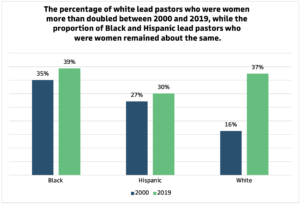
- In 2000, about 35 percent of Black lead pastors and only 16 percent of white lead pastors were women. From 2000 to 2019, the percentage of white pastors made up of women more than doubled, reaching 37 percent in 2019. Among Black and Hispanic pastors, however, there was very little change in the percentage of pastors comprised of women between 2000 to 2019.
- By 2019 there was almost no difference in the proportion of Black and white lead pastors who were women. Thirty-nine percent of Black pastors and 37 percent of white pastors were women. Women comprised 30 percent of Hispanic pastors [3].
3. Women led smaller congregations than men (in terms of median worship attendance) throughout the past two decades, although this gap narrowed throughout this period.
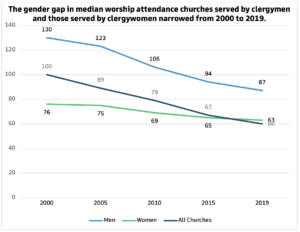
- In 2000, the median worship attendance of congregations led by men was 130 people, whereas the median worship attendance of congregations led by women was only 76 individuals.
- By 2019, the disparity in worship attendance of congregations led by women and men had decreased, but this is mainly because all congregations shrank over this period. The overall worship attendance of ELCA congregations decreased by 40 percent.
- The median worship attendance of congregations led by men decreased by 33 percent, whereas the worship attendance of congregations led by women decreased by 17 percent.
4. Women led congregations with fewer financial resources (in terms of congregations’ total expenditures) than those of congregations led by men throughout the period of 2000 to 2019. However, this gap narrowed throughout these two decades.
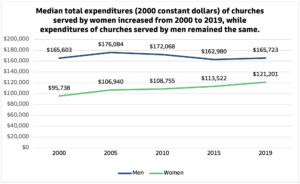
- The total expenditures of churches led by women increased by close to 27 percent (even after accounting for inflation), whereas the expenditures of congregations led by men increased by less than 1 percent.
- In 2000, the median total expenditures of congregations served by clergywomen were 42 percent lower than the expenditures of congregations served by clergymen. By 2019, clergywomen served congregations with total expenditures that were 27 percent lower than the expenditures of congregations served by clergymen.
Clergywomen in the ELCA have made significant gains over the past two decades. However, they still have a way to go before they reach parity with clergymen in terms of the number of worshippers and financial resources of the congregations they serve. These findings are consistent with the findings of past research studies, which show that women tend to lead smaller congregations with fewer economic resources than do men[4].
[1]Gracia Grindal, “Women in the Evangelical Lutheran Church in America,” in Religious Institutions and Women’s Leadership: New Roles Inside the Mainstream, ed. by Catherine Wessinger (Columbia, SC: University of South Carolina Press, 1996), 180.
[2] Adam DeHoek, “45th Anniversary of the Ordination of Women: Gender Differences in Retention Rates among Ordained Clergy,” (ELCA Research and Evaluation, Office of the Presiding Bishop, 2016), 18. bit.ly/3ILzxDy.
[3] Results of crosstabulations of pastors’ race by gender in 2019 showed that there is no statistically significant differences in percentages of female or male pastors who comprise pastors of each racial group (Pearson chi-square = 9.12, p = .426).
[4] Mary Ellen Konieczny and Mark Chaves, “Resources, Race, and Female-Headed Congregations in the United States,” Journal for the Scientific Study of Religion 39, no. 3 (2000): 264-268; Charles W. Mueller and Elaine M. McDuff, “’Good’ Jobs and ‘Bad’ Jobs: Differences in the Clergy Employment Relationship,” Review of Religious Research 44, no. 2 (2002): 160-162.
Photo credit: National Catholic Reporter at https://www.ncronline.org/news/celebration-whole-church-lutheran-women-reflect-50-years-ordination

